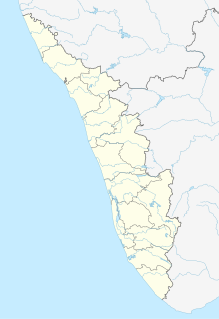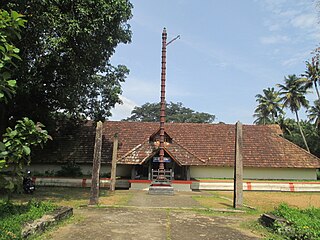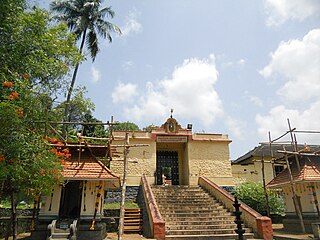
Meenachil is the north-eastern region of Kottayam district in Kerala, south India. The name originates from Meenakshi, the Dravidian goddess. Pala is the main city in Meenachil. The arterial river of the district is also named Meenachil.

The Panachikkadu Temple, also known as the Dakshina MookambikaTemple, is a Hindu temple dedicated to the goddess Saraswati. The temple is located in the southern region of the Indian Peninsula, in Panachikkad in Kottayam District, Kerala, India. It is one of the most prominent Saraswati temples for devotees in Kerala. But, the main deity of the temple is Lord Vishnu, who was installed long before Goddess Saraswati. Still the temple is known as Saraswati temple, due to the popularity of the Goddess. There are sub-shrines for Lord Shiva, Lord Ganapathi, Lord Ayyappan, Snake deities and Panachikkattu Yakshi inside the temple.

Kidangoor is a village in Kottayam district, near Pala in Kerala. It is strategically located between the two major towns in Kottayam District, Kottayam and Pala.

Kadappattoor is a small village on the banks of Meenachil river near Pala in Kottayam district of Kerala. Kadappattoor, is located 30 km east of Kottayam. The village life is centered on the Shiva Kadappattoor Mahadeva Temple The population consists of Hindus and Christians.

Thiruvangad Sree Ramaswami temple is an important temple located in the east part of Thalassery. The temple is generally known as the Brass Pagoda from the copper sheeting of its roof. A part of the temple was damaged by Tipu Sultan's troops in the 18th century, but the temple itself is believed to have been saved from destruction. It was one of the outposts of the Thalassery fort in the eighteenth century. In its precincts were held many conferences between the officials of the East India Company and local leaders, at which political treaties and agreements were signed. The temple contains some interesting sculptures and lithic records. The annual festival of temple commences on Vishu day in Medam (April–May) and lasts for seven days.

Vilwadrinatha Temple is a Hindu temple located in Thiruvilwamala, Thrissur district of Kerala. Lord Rama, the seventh avatar of Lord Vishnu, and his brother Lord Lakshmana are the main deities of this temple. This is one of the four major temples in Kerala dedicated to Lord Rama, the other three being Thriprayar, Kadavallur and Thiruvangad temples, and also one of the rarest temples in India itself which houses Lord Lakshmana. The temple is situated on the middle of Thiruvilwamala village, on the top of a hill 100 ft above the sea level. Bharathappuzha, the second largest river in Kerala, flows through the northern side around 3 km away from the temple, and as the temple is situated on the top of a hill, the river can be clearly seen from the temple.

Sreevallabha Temple is a highly orthodox Hindu temple dedicated to Lord Sreevallabhan. It is one of the oldest and biggest Temples of Kerala, and has been a major destination for devotees all over India for centuries. Located in Thiruvalla city, this ocean of orthodoxy is well known for its architectural grandeur and unique customs that can be found in no other temples. There are stone-wooden carvings and mural paintings inside the temple. Being one among 108 Divya Desams, Sreevallabha temple has been glorified by Alvars and many other ancient works. It is considered to be the vallabha kshethram mentioned in Garuda Purana and Matsya Purana. Kathakali is played daily in the temple as an offering, pushing it to the top in India in terms of places where Kathakali is staged in largest number of days per year. Lord Vishnu appeared here as Sreevallabhan for sage Durvasa and Khandakarnan. Pleased by prayers of an old Brahmin lady Sreevallabhan incarnated as a brahmachari and killed the demon Thokalaasuran. Later the deity of Sreevallabhan worshipped by Lakshmi and Krishna has been installed in the temple in 59 BC. From then till date, the temple follows its own worship protocol that is known to be followed nowhere else yet. Sage Durvasa and Saptarishi are said to reach the temple every midnight for worshipping the Lord. The temple had governed one of the biggest educational institutions in ancient time and heavily contributed to the cultural and educational developments of Kerala

Ettumanoor Mahadeva temple is an ancient Shiva temple in Kottayam, Kerala, India. Temple tradition has it that the Pandavas and the sage Vyasa had worshipped at this temple. The name of the place has its origin from the word manoor, which means "the land of deer." The temple is one of the major Shiva temples in Kerala, along with Vaikom Temple, Chengannur Mahadeva Temple, Kaduthruthy Mahadeva Temple, Ernakulam Shiva Temple, Vazhappally Maha Siva Temple and Vadakkunathan temple.

Janardana Swami Temple is a 2000-year-old temple situated in the municipality of Varkala city in Trivandrum. It is also known as Varkala Temple. Janardana Swami is a form of Lord Vishnu. It is a very well known temple in Kerala about 10.9 km west of Kallambalam on NH 66 near sea, 25 km north of Thiruvananthapuram city, 8 km south of famous backwater destination Kappil and 2 km from Varkala Railway Station,14 km north west of Attingal municipality. It is situated near the Arabian sea shore.It is referred to as Dakshin Kashi. The temple is located close to the Varkala Beach, which is considered to have medicinal properties since the waters wash the nearby medicinal plants. It is also an important Ayurveda treatment center. The temple has an ancient bell removed from a shipwreck, donated by the captain of the Dutch vessel which sank near Varkala without causing any casualties.

The Thrichittatt Mahavishnu Temple is a Hindu temple dedicated to Supreme God Vishnu and located in Chengannur, Alappuzha District, Kerala, South India. Constructed in the Kerala style of architecture, the temple is glorified in the Divya Prabandha, by Nammalwar, one of the saint poets of the 8th century. It is one of the 108 Divyadesam dedicated to Krishna, an avatar of Vishnu, who is worshipped as Imayavarappan. The nearest railway station to the temple is located in Chengannur, while the nearest airports are Trivandrum International Airport and Nedupumpassery Airport Ernakulam.
Sree Dharma Sastha Temple is situated at Thycaud in Thiruvananthapuram City near to Govt. Model School and Govt. Arts College. This ancient Hindu temple is dedicated to Lord Dharma Sastha. The distance from the temple to Thiruvananthapuram International Airport is 8 km and to the Central Railway Station and Bus Station is 1.5 km. The temple is administered by Nair Service Society.

Kulathupuzha Sastha Temple is a Hindu temple located on the banks of Kulathupuzha river, a tributary of Kallada River. It is located in Kulathupuzha in Punalur tehsil of Kollam district in the Indian state of Kerala. The presiding deity there is Lord Ayyappa in the form of Balasastha. It is also one among the pancha sastha shrines and one of the 108 Sastha shrines in Kerala. The idol there is believed to be installed by Lord Parashurama, and is made up of eight pieces of stones.
Poonjar dynasty was one of the royal dynasties in medieval Kerala descended from the Pandya kings of Madurai. History has it that Manavikrama Kulasekara Perumal, a Pandya king as the sole founder of the dynasty. It was a minor principality in the central Travancore region which covered the parts of present-day Dindigul, Cumbum, Kudallor, Bodinayakkanur, Vandiperiyar, Peerumedu and Kannan Devan hills.

Achankovil Sastha Temple is a Hindu temple and one of the 108 Sasthalayas, located in Pathanapuram tehsil of Kollam district in the Indian state of Kerala. It is also one among the famed Pancha Sastha temples in Kerala, the other four being Kulathupuzha, Aryankavu, Sabarimala and Kanthamala temples. The temple is near the origin of the famous Achankovil river, named after the locality.

Sree Krishna Swami Temple is a Hindu temple situated at the heart of Thodupuzha town in Idukki district in the Indian state of Kerala. It is located on the banks of Thodupuzhayar, a tributary of river Muvattupuzha. Lord Krishna presides there in the form of Navaneetha Krishna who holds butter in his right pam. The tantric rights of the temple is held by the Aramallur Kavanattu Mana. The Poojas are conducted by two mutts named as 'Padinjare mutt' and 'Thuruthel mutt'.

Parippu Mahadeva Temple is a Hindu temple located in Parippu in Aymanam panchayath of Kottayam district, in the Indian state of Kerala. This temple mentioned as Nalparappil in the renowned Shivalaya stotra is closely related to Thekkumkur raja. Currently it is administered by Travancore Devaswom Board. Bhadrakali Mattappally Nambudiri holds the tantric rights of the temple.

Pandavam is a village in Aymanam panchayath in Kottayam District in the Indian state of Kerala. It is located near Kudayampady on Kottayam - Olassa - Parippu route.

Sree Rama Swami Temple is an ancient Hindu temple located in Ramapuram village in Meenachil tehsil and near Pala in Kottayam district in the Indian state of Kerala. The temple has Lord Rama as principal deity, facing the east, who is in the form of "Chathurbahu" (four-armed). It is managed by a trust called Ramapuram Devaswom consisting of three Nambudiri families of Amanakara mana, Kunnoor mana and Karanattu mana.

Talikotta Mahadeva Temple is an ancient Hindu temple dedicated to Shiva is located on the banks of Meenachil River on Kottayam - Kumarakom Road in Kottayam District in Kerala state in India. The Keezhtali Mahadeva Temple is one of the important temples in Thekkumkur Kingdom. According to folklore, sage Parashurama has installed the idol of Shiva. The temple is a part of the 108 Shiva Temples in Kerala. The temple is one of the four thali temples mentioned in the 108 Shiva temple sothram The temple houses Lord Shiva in his most angry form. There are sub-shrines for Ganapathi, Ayyappan and Bhadrakali in the temple.























